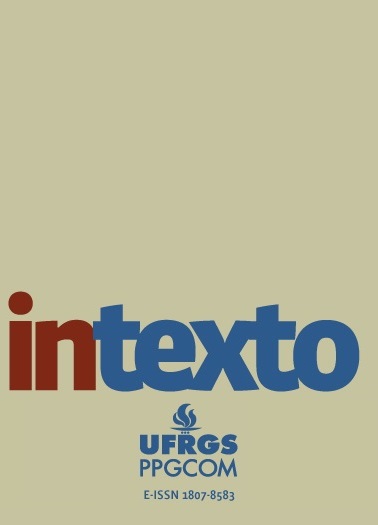An abstract landscape: Fargo, the error and the mental-image
DOI:
https://doi.org/10.19132/1807-8583202152.99882Keywords:
Mental-image, Coen Brothers, DeleuzeAbstract
Fargo, a film by Joel and Ethan Coen, will be analyzed aiming to interpret it towards Deleuze's concept of mental-image. Despite his apparent format of conventional crime comedy, this opus consists of an example of a work localized at the edge of classical cinema, never breaking with its limits. The film is understood as an indication of a detachment from the action-image, recurring less to the synsign/binomial, resource intrinsic to the secondness. In Fargo, the contraposition between the acts and the events which will guide then from a situation to another becomes dispensable. Submitting the gestures to an idea, it becomes possible to the movie to operate according to a thirdness, introducing thinking in the image and conferring centrality to a concept defined by the error, which the work happens to be his illustration. Fargo exploits this mechanic, in gestures condemned to conduct to the destruction of everything that constitutes his plot.
Downloads
References
ADAMS, Jeffrey. The Cinema of the Coen Brothers: Hard-Boiled Entertainments. Nova York: Wallflower Press Book, 2015.
BORDE, Raymond; CHAUMETON, Etienne. A Panorama of American Film Noir 1941-1953. San Francisco: City Lights Books, 1953.
CIMENT, Michel; NIOGRET, Hubert. Interview with Joel and Ethan Coen. In: ALLEN, WILLIAM RODNEY (Org.). The Coen Brothers: Interviews. Minneapolis: University of Minnesota Press, 2006. p. 25.
CLOVER, Carol J. Men, Women, and Chain Saws: Gender in the Modern Horror Film. Princeton: Princeton University Press, 2015.
COEN, Ethan. Introdução. In: COEN, ETHAN; COEN, JOEL. Fargo. Rio de Janeiro: Rocco, 1997. p. 5–9.
DELEUZE, Gilles. A Imagem-Movimento. São Paulo: Brasiliense, 1983.
DELEUZE, Gilles. A Imagem-Tempo. São Paulo: Brasiliense, 1985.
DOUCHET, Jean. Hitch et son public. Cahiers du Cinéma, Paris, v. 113, p. 7–15, nov. 1960.
DOUCHET, Jean. La Troisième clé Hitchcock. Cahiers du Cinéma, Paris, v. 99, p. 44–55, set. 1959a
DOUCHET, Jean. La Troisième clé Hitchcock (II). Cahiers du Cinéma, Paris, v. 102, p. 17–29, dez. 1959b.
DUNNE, Michael. Barton Fink’: intertextuality, and the (almost) unbearable richness of viewing. Literature-Film Quarterly, Nova York, v. 28, n. 4, p. 303–311, out. 2000.
FARGO. Direção de Joel Cohen e Ethan Coen. Produção de PolyGram Filmed Entertainment, Working Title Films. Seattle: Amazon Prime, 1996. (96 min), color.
HINSON, Hal. Bloodlines. In: ALLEN, WILLIAM RODNEY (Org.). The Coen Brothers: Interviews. Minneapolis: University of Minnesota Press, 2006. p. 3–16.
LEITCH, Thomas. Crime Films. Cambridge: Cambridge University Press, 2002.
LEVINE, Josh. The Coen Brothers: The Story of Two American Filmmakers. Toronto: ECW Press, 2000.
LEWIS, Jon. The Coen Brothers. In: TASKER, Yvonne (Org.). Fifty Contemporary Film Directors. Nova York: Routledge, 2011. p. 116–126.
MARRATI, Paola. Gilles Deleuze: Cinema and Philosophy. Baltimore: Jonhs Hopkins University Press, 2008.
MOTTRAM, James. The Coen Brothers: The Life of the Mind. Dulles, VA: Brassey’s, Inc, 2000.
PALMER, R. Barton. Joel and Ethan Coen. Champaign: University of Illinois Press, 2004.
RODOWICK, David Norman. Gilles Deleuze’s Time Machine. Durham: Duke University Press, 1997.
ROHMER, Eric; CHABROL, Claude. Hitchcock, the First Forty-Four Films. Nova York: Ungar Film Library, 1979.
SEELEY, Tracy. O Brother, What Art Thou? Postmodern pranksterism, or parody with a purpose?. Post Script, Nova York, v. 27, n. 2, p. 97, 2008.
THOMPSON, George. Hammett’s Moral Vision. San Francisco: Vince Emery Productions, 2007.
TRUFFAUT, François; HITCHCOCK, Alfred. Hitchcock/Truffaut: Entrevistas. São Paulo: Companhia das Letras, 2004.
Downloads
Published
How to Cite
Issue
Section
License
Copyright (c) 2021 João Martins Ladeira

This work is licensed under a Creative Commons Attribution-NonCommercial 4.0 International License.
The copyright of works published in this journal belong to the authors, and the right of first publication is conceded to the journal. Due to the journal being of open access, the articles are of free use in research, educational and non-commercial activities.
Therefore, the journal uses the License Creative Commons Attribution (CC BY-NC 4.0), which allows sharing of work with acknowledgment of authorship.
Self-archiving (repository policy): authors are allowed to deposit all versions of their work in institutional or thematic repositories without embargo. It is requested, whenever possible, that the full bibliographic reference of the version published in Intexto (including the DOI link) be added to the archived text.
Intexto does not charge any article processing fees (article processing charge).















